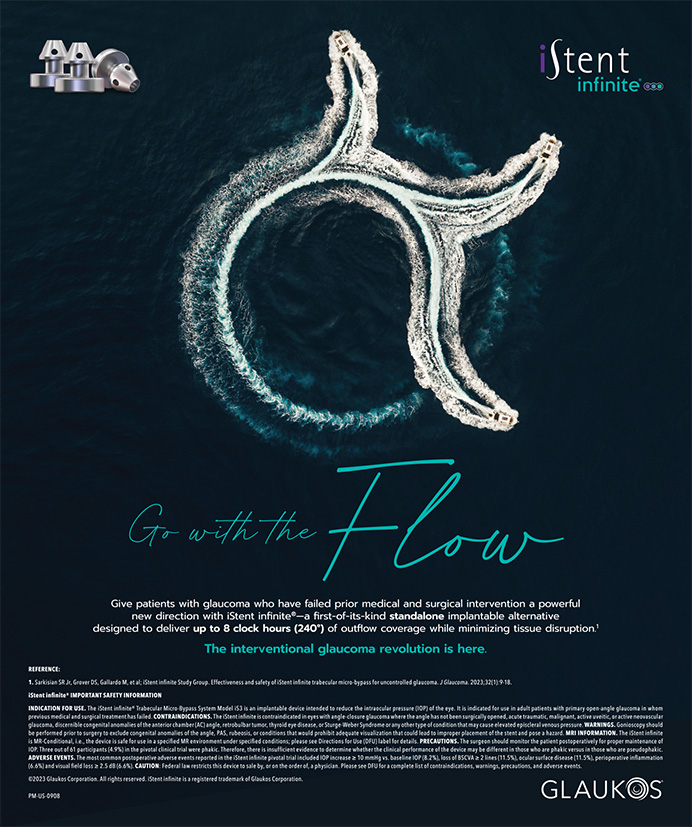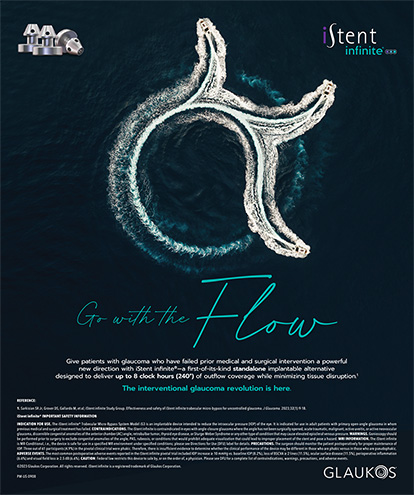Ocular surgery has undergone an extraordinary evolution. Much of the science that we now take for granted—drugs, instruments, technology, and procedures—was developed only within the past few decades. As recently as 1973, ophthalmologists' treatment options were far more limited than they are today. There were no microincisions, self-sealing wounds, or Nd:YAG lasers. IOLs were an exciting innovation, but phacoemulsification had yet to be invented. In terms of ocular drugs, prednisolone acetate had just been approved for the treatment of ocular inflammation.
Today, cataract surgery with IOL implantation is one of the most common surgical procedures performed in the United States. Its impressively low rate of complications also makes it one of the safest operations in this country. Incisions have become incredibly small, thanks to the development of foldable IOLs and other technological breakthroughs.
Pharmacological developments, however, have not kept pace with the tremendous advances in ocular surgery. We physicians need a steroid that treats inflammation and pain effectively without the risk of untoward adverse events and that permits less frequent dosing. With the recent approval and launch of Durezol (difluprednate ophthalmic emulsion) 0.05 (Sirion Therapetuics, Inc., Tampa, FL), we may have an option that provides us with some of these desired attributes.
THE NEXT STEP
Topical corticosteroids were first used in the 1950s and have become the primary treatment for most types of ocular inflammation. Their mechanisms of action diminish the effects of existing inflammatory mediators, disrupt the inflammatory cascade, suppress the production of critical proteins, and hinder the creation of further inflammatory mediators.1
The most commonly prescribed ophthalmic corticosteroid is prednisolone acetate 1, a strong steroid, formulated as a suspension (data on file with Sirion Therapeutics, Inc.). The standard recommended dosing for this drug is q.i.d. for the treatment of inflammation. Loteprednol etabonate, 0.5, another commonly prescribed steroid, is also typically dosed q.i.d. In more serious cases, like severe uveitis, prednisolone acetate is often used every hour and sometimes even more frequently.2
NEW CORTICOSTEROID
Difluprednate (difluoroprednisolone butyrate acetate) is a difluorinated prednisolone derivative. Its molecular formula is C27H34F2O7 (Figure 1), and it has a molecular weight of 508.5. Fluorination at the C6 and C9 positions contributes to the agent's potency,3 and substituting the 21-hydroxyl group with acetic acid increases both the drug's lipophilicity and corneal penetration; replacing the 17-hydroxyl group with butyric acid enhances the steroid's anti-inflammatory activity.4
Senju Pharmaceuticals Co., Ltd. (Osaka, Japan), studied difluprednate given q.i.d. in a robust series of preclinical and clinical trials. These studies demonstrated the agent's efficacy at and safety for treating postoperative inflammation as well anterior uveitis and panuveitis.5-9 In 2005, Senju licensed the worldwide development and marketing rights (except for Asia) to Sirion Therapeutics, Inc. Durezol was approved by the FDA in June 2008 as the first topical steroid indicated for both inflammation and pain associated with ocular surgery. Durezol is also being studied for the treatment of uveitis.
PHASE 3 CLINICAL TRIALS
Difluprednate is currently approved for postsurgical use at q.i.d. dosing. Phase 3 postsurgical clinical trials conducted in the United States made clear, however, that b.i.d. dosing is quite effective, even numerically outperforming the q.i.d. arm for some performance measures at certain time points.10
As the largest enroller in those US trials with over 50 patients, I was able to see firsthand how effectively this new therapeutic agent fights inflammation and pain. One subject in the b.i.d. arm of the trial that was enrolled at my site, for example, entered the study with an anterior chamber cell count grade of 4 (> 50 cells), a pain score of 37 mm on the Visual Analog Scale (a validated assessment tool that measures patient-reported pain from 0 [no pain] to 100 mm [maximal pain] on a 100-mm line), severe corneal edema, and bulbar conjunctival injection. By day 15, the anterior chamber cell count was 4, the pain score had fallen to 1, the edema was mild, and there was no sign of injection. On day 29, both the anterior chamber cell grade and pain score were zero, and the injection and edema had disappeared. Although this is an extreme example, it demonstrates that, for some patients, Durezol may be effective at this b.i.d. dosing frequency.
Although b.i.d. is considered an off-label use of Durezol, the results from the pivotal trials may give confidence to doctors who choose to use difluprednate in this fashion for some of their postsurgical patients. Certainly, the results of the trials give physicians the flexibility to tailor dosing regimens to patients' particular needs. Furthermore, the option of less frequent dosing may improve patient's compliance.
POTENTIAL FOR LESS IRRITATION AND MORE POTENCY
Unlike other topical ophthalmic steroids available in the United States, difluprednate does not contain benzalkonium chloride, a quaternary ammonium11 and detergent12 known to create toxic effects in the corneal and conjunctival epithelia, disrupt tear film stability, and cause immunoallergic reactions.13 Difluprednate has instead been formulated with sorbic acid, a preservative shown to cause little damage to ocular tissue or irritation.14 It is a preferred preservative for sensitive eyes.15
More importantly, previous studies conducted in Japan that evaluated difluprednate against betamethasone showed comparable and, in some cases, better results in treating both postoperative inflammation and uveitis. This is noteworthy because betamethasone is six times more potent than prednisolone on a molecular basis.16 Although not approved for use in the United States, betamethasone is available in Europe, Canada, and Japan, and it is frequently used to evaluate the potency of new therapies.
One study of difluprednate conducted in Japan included patients with severe refractory uveitis who had been treated unsuccessfully with betamethasone 0.1, dosed in excess of the q.i.d. label instructions—most between eight and 12 times a day. Even in this especially challenging group of patients, difluprednate administered q.i.d. for 2 weeks effectively reduced anterior chamber cell, flare, and total sign and symptom scores.8 I am not aware of another drop in the United States for which this claim can be made.
Recent results from a pivotal US uveitis trial comparing Durezol q.i.d. and Pred Forte (Allergan, Inc., Irvine, CA) dosed eight times per day are also very encouraging (see Pivotal Uveitis Trial Shows Positive Data). Although this was designed as a noninferiority trial, Durezol demonstrated comparable and numerically superior results to Pred Forte, even though it was dosed at half the frequency. These results, combined with a benzalkonium chloride-free formulation, may be especially helpful to patients suffering from a debilitating chronic disease such as uveitis. These outcomes will be combined with data from previous trials conducted in Japan to support a supplemental New Drug Application for anterior uveitis.
With any steroid, the potential for increased IOP is a big concern. In the pivotal studies, 3 of subjects in each difluprednate group had a clinically significant rise in IOP (an increase of ≥ 10 mm Hg from baseline and a reading of ≥ 21 mm Hg) at the same study visit versus 1 in the placebo group. It is important to note, however, that these studies were only 28 days long. A long-term study to assess the effects of Durezol on IOP is needed.
Because it has demonstrated an excellent safety profile and a low potential for causing elevations in IOP during the short duration of postoperative care, difluprednate may be a treatment option for a much wider variety of patients than currently available agents. Difluprednate may an off-label use for dry eye, ocular allergy, infection-related inflammation, and ocular surgery other than cataract procedures. The agent may be particularly useful for the treatment of inflammation following glaucoma surgery, which, in my experience, typically takes longer to resolve than inflammation after cataract surgery.
CONCLUSION
Difluprednate appears to be a much-needed advance in topical steroid therapy. It clears inflammation and pain rapidly and effectively, has a low potential for adverse events,?and has a low propensity for elevating IOP in short-term standard clinical use. This steroid is a welcome addition to the ophthalmic pharmacopoeia. Over the next few years, Sirion Therapeutics, Inc., will perform additional clinical trials to further study the full potential of difluprednate. Already, the agent has demonstrated significant benefits for patients in clinical trials.
Michael Korenfeld, MD, is Assistant Clinical Professor at the Washington University Department of Ophthalmology and Visual Sciences in Washington, Missouri. He was an investigator in the phase 3 Durezol trials and currently is under a consulting agreement with Sirion Therapeutics, Inc. Dr. Korenfeld may be reached at (636) 390-3999; michaelkorenfeld@hotmail.com.


